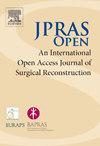Topical Tranexamic Acid and Chest Masculinization Surgeries—Impact on Postoperative Hematoma Incidence
IF 1.5
Q3 SURGERY
引用次数: 0
Abstract
Introduction
Postoperative hematoma requiring intervention occurs more frequently in chest masculinization surgeries than in other types of breast surgeries, with incidences ranging from 0.7% to 13.2% per patient. Although there is increasing evidence that topically applied tranexamic acid (TXA) effectively reduces postoperative bleeding in breast surgeries, its impact on masculinization surgeries is understudied.
Aims
Examining the significance of topical TXA in reducing postoperative hematoma in chest masculinization surgeries.
Methods
This retrospective cohort comprises female-to-male transgender and non-binary patients who underwent chest masculinization at Helsinki or Tampere University hospitals between 2018 and 2024. Topical TXA (20 mg/ml, 25 ml per breast) was incorporated into routine use in October 2022, replacing the previous practices; Helsinki mainly operated without TXA, whereas Tampere routinely used intravenous (i.v.) TXA.
Results
A total of 198 patients undergoing chest masculinization surgery were included. Among them, 9 (4.5%) major hematomas occurred. The need for reoperation due to postoperative hematoma was lower in the topical TXA (3.2%, 2 out of 63 patients) and i.v. TXA (3.4%, 2 out of 58 patients) groups compared to the non-TXA group (6.5%, 5 out of 77 patients). Subpectoral incisions (71.2%, 141 patients) resulted in a 5.0% hematoma rate, whereas periareolar incisions (28.8%, 57 cases) had a 3.5% hematoma rate.
Conclusions
Our study suggests that topical and i.v. TXA effectively reduce postoperative bleeding in chest masculinization surgeries, with similar outcomes between the 2 methods. Albeit our results lack statistical significance and they support the potential benefit of prophylactic TXA use in hematoma reduction.
求助全文
约1分钟内获得全文
求助全文
来源期刊

JPRAS Open
Medicine-Surgery
CiteScore
1.60
自引率
0.00%
发文量
89
审稿时长
22 weeks
期刊介绍:
JPRAS Open is an international, open access journal dedicated to publishing case reports, short communications, and full-length articles. JPRAS Open will provide the most current source of information and references in plastic, reconstructive & aesthetic surgery. The Journal is based on the continued need to improve surgical care by providing highlights in general reconstructive surgery; cleft lip, palate and craniofacial surgery; head and neck surgery; skin cancer; breast surgery; hand surgery; lower limb trauma; burns; and aesthetic surgery. The Journal will provide authors with fast publication times.
 求助内容:
求助内容: 应助结果提醒方式:
应助结果提醒方式:


